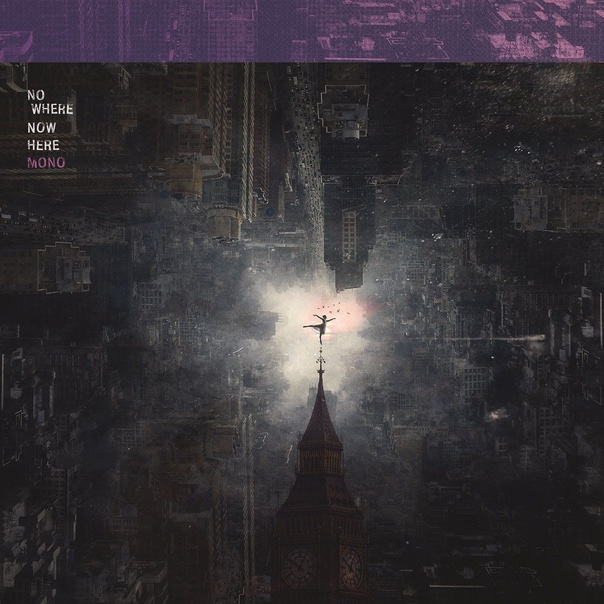ALBUM REVIEW: Mono’s sonic ocean deepens with ‘Nowhere, Now Here’
Unlike contemporaries This Will Destroy You and Explosions in the Sky, Japan’s Mono approaches post-rock like a composer with the meticulous orchestration and overwhelming scope of Jóhann Jóhannsson and Max Richter. Orchestral, minimal and even metal music has found a place in the band’s nine sprawling instrumental epics, with seemingly nothing out of bounds. This freedom allows Mono to deepen the sonic ocean of Nowhere, Now Here with electronic textures without subverting its post-rock template.
Nowhere, Now Here
Mono
Temporary Residence Ltd., Jan. 25
The dreary string and trumpet cadences of “God Bless” provide a lull for the hard-cut downbeat of “After You Comes the Flood” to break. The lead single shows Mono at its most explosive, with Dahm Majuri Cipolla’s blistering drum fills proving he can carry the torch of founder Yasunori Takada. His pummeling aggression drives rhythm guitarist Hideki Suematsu’s and bassist Tamaki Kunishi’s evolving noise-mongering, as lead guitarist Takaakira Goto continually contextualizes the song’s multifaceted central lick.
The real shocker comes when Kunishi debuts her singing voice on “Breathe.” It’s a sublime cut in the vein of Sigur Rós’ Valtari. Her voice glimmers like sunlight on a pond as lofty string arrangements build on the foundation of oblique synth. As Kunishi’s final notes fade into the ambiance, the instrumentation only gets more heavenly. A backbeat and nuanced tremolo picking bring the song’s rapturous melodies to a spellbinding head. These two singles are the biggest curveballs on Nowhere, Now Here, connected by the immersive visual accompaniment from Julien Levy. Still, the deeper cuts have plenty to offer.
The title track, “Sorrow” and “Meet Us Where the Night Ends” are the post-rockers’ most “rock” songs. These multi-movement audacious tunes reinstate Mono as true masters of massive chords and sweeping crescendos. And yet, the instruments maintain a grounded, earthy timbre. In the first cut, Cipolla’s snare punches through a bed of brass, synth and Takaakira’s noodling melody.
Layers of reverb and orchestration ascend like clusters of balloons reaching the clouds—but then the second half kicks in. Major key modulations take the ascension to hyper speed, as Cipolla and Kunishi break into a syncopated frenzy. By the time it all reaches critical mass, Takaakira’s and Suematsu’s harmonized strains feel like continents colliding.
The other two cuts share a propensity for massive build-ups. The difference is how they get there and to what effect. The spacious three-count beat of “Sorrow” creates the perfect backdrop for morose guitar lines and melancholic atmosphere, while “Meet Us Where the Night Ends” builds a groovy space-rock jam on a collage of spectral vocal samples. Both tracks see Mono shift time dynamics like a compelling plot twist in a mystery movie. Seismic arrival points surprise in its heft, constantly taking things one step further in terms of volumes—like the former cut’s heartbreaking cello melodies or the latter’s Buddy Rich-style snare roll cadence into a sonic supernova.
Nowhere, Now Here’s electronic ventures never overwhelm the band’s usual instrumentation. “Far and Further” might find its rhythmic footing on an electronic bass drum heartbeat, but its soundscape is undeniably guitar-based. The track’s use of effects also blends synthetic and acoustic instruments, almost to nullify such differences in the face of the mesmerizing whole.
The mostly acoustic “Parting” creates an engulfing waterfall of sound with warm string sections and delicate piano, just like “Funeral Song” proves that austere brass harmonies can nestle in thickets of droning keyboards. Mono doesn’t have to “go electronic.” The band simply uses its expanded reserve of sound to illuminate different regions of its aural landscape.
“Vanishing, Vanishing Maybe” closes the album with soft-spoken guitar picking and demure electro-acoustic ambiance, ending the record with traditional post-rock serenity. Mono’s complex sound already gives the band plenty of creative leeways, so it hardly relies on newfound synths. The supplemental textures become another tool in the arsenal of these veteran musicians as they continue their vast journey.
Follow editor Max Heilman at Twitter.com/madmaxx1995 and Instagram.com/maxlikessound.

